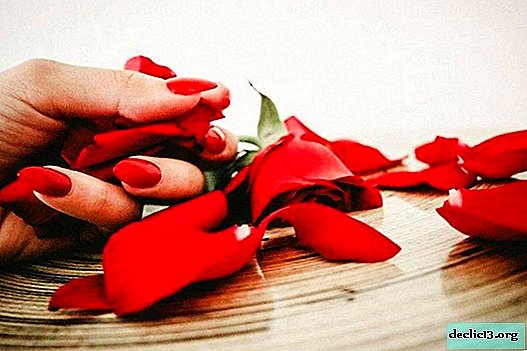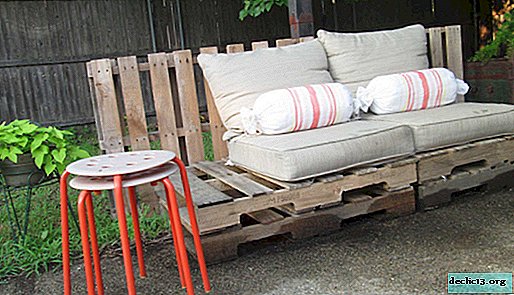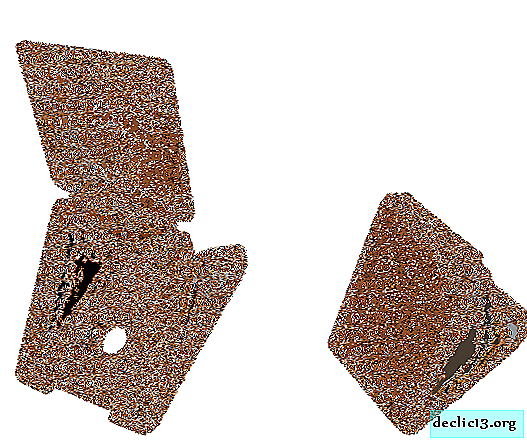Recommendations for the care of orchids: what should be done when she released the flower stalk?
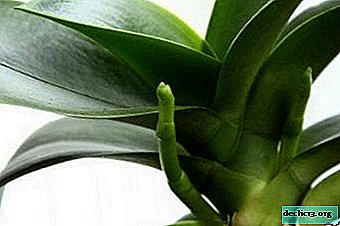
Many of us consider the Orchid the most beautiful flower in the world, a plant of some unreal beauty. And when the flower arrow begins to grow, then we wait with a bated breath - when will the buds appear and how will they open. After all, this is really true magic and, of course, I want to keep this fairy tale as long as possible. And for this, you just need to properly and competently look after your favorite.
In the article, we will consider what needs to be done already after when she released the flower stalk, and also what are the differences between caring for a plant before and after flowering.
What does a kidney awakening mean for a plant?
With the onset of autumn, the Orchid ends the dormant period and the plant begins to prepare for its most important period - flowering. Naturally, she strove for this, accumulated strength, and now there comes a moment when peduncles sprout.
After about two months, instead of small buds, the opened flowers will already show off on them. Therefore, it is very important during this period to give the flower the maximum amount of attention and care, properly water, fertilize and provide good lighting.
Reference. If during the past flowering period you did not cut the peduncle to the base, then in the fall, a sleeping bud may wake up on it and a lateral flower arrow will begin to grow (flowers will appear on it faster - after 1.5 months).You can learn more about what a peduncle of an orchid is and how it appears, here.
The principles of flower maintenance before and during the appearance of buds - what is the difference?
The care in these different periods, of course, is different, let's compare:
- Care before ejection - while the plant is resting (does not bloom), it must be carefully taken care of so that it has the strength for long flowering:
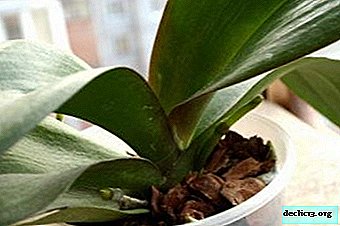 Watering is necessary as the roots dry.
Watering is necessary as the roots dry.- Maintain proper humidity and temperature.
- Lighting must be active.
- Carefully and regularly look at the flower for pests.
- Feeding should not be carried away, otherwise the Orchid may begin to “fatten”, grow leaves and roots, but not bloom.
If it still does not bloom for a long enough time, you need to arrange "stress", that is, create conditions that are completely uncomfortable: either move it to a darker place, or create a small "drought" (watering drastically reduce). After such actions, peduncles are usually born.
- Peduncle care - no less thorough, of course, you need bright light, and air humidity must be appropriate, the temperature regime must be observed, but top dressing after the peduncle is born, we immediately resume in the normal norm. At this moment, they greatly affect the health status of the whole Orchid bush in general and the quality of flowering, in particular.
Step-by-step care instructions
So, what to do next, when the orchid has already given a peduncle? If you follow all the tips and recommendations for care, then flowering will please our eyes for a long time. Let us dwell on the most important points:
- Seat selection - after ejecting the peduncle, the pot must be placed on the windowsill of the east or west window, there are light and not scorching sunlight. If there is only one window and it faces the south side of the house, then only shading will save from burns and other problems.
- Temperature - in the autumn - in winter, the temperature must be maintained within 20 - 25 degrees, this is a comfortable temperature for blooming Orchids. Nighttime temperature differences should be minimal.
- Humidity - required humidity: 60 - 70%, it is not so easy to achieve it in the heating season, the air in the apartments becomes extremely dry. Of course, it would be nice to use a special air humidifier, but from an ideal means, you can put a flower pot in a large container of water, pebbles or expanded clay is poured on the bottom so that the water evaporates.Recommendation. Orchid should be sprayed with warm water and only before lunch, after dinner is undesirable.
- Lighting - bright diffused light is required, when the daylight becomes short, it is imperative that you additionally highlight your flower so that the buds and flowers do not crumble; lack of light will instantly affect the appearance of the flower.
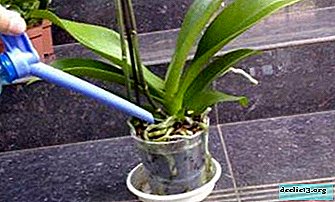 Watering - this plant, of course, loves moisture and in the period of the beginning of flowering, drying of the soil should not be allowed, but it is strongly recommended not to over-moisten it (risk of decay of the root system). If the orchid threw a flower stalk in the fall, then it will be necessary to water it about 1 time per week, and it is better to lower the pot into the water for impregnation of the guna, then the water will drain and put it back in its place.
Watering - this plant, of course, loves moisture and in the period of the beginning of flowering, drying of the soil should not be allowed, but it is strongly recommended not to over-moisten it (risk of decay of the root system). If the orchid threw a flower stalk in the fall, then it will be necessary to water it about 1 time per week, and it is better to lower the pot into the water for impregnation of the guna, then the water will drain and put it back in its place.- Top dressing - at this time, it is absolutely necessary to apply approximately twice a month, it is better to use special liquid fertilizers for Orchids, everything is balanced there.
Problems and difficulties
When growing such an interesting tropical plant in an apartment, of course, sometimes some difficulties arise, for example:
- Orchid does not want to bloom - this may be due to too hard watering or improper watering.
- If you water a flower in a pot in which there is good drainage, then the water will spill quickly and the soil will not have time to get wet and saturated with moisture, that is, the plant simply does not have enough water.
- If poor drainage and soil are strongly intertwined with roots, then with constant watering in a pot, the root system will begin to decay - there is no time for flowering.
Therefore, watering must be by immersion.
- The flower stalk turns yellow - it would seem that the flower stalk has begun to grow, everything is fine, we are waiting for the appearance of buds and flowers, however, it may happen that it suddenly stops growing and starts to turn yellow and dry.
The reason may be that the plant is not yet ready for flowering, which we artificially provoked (arranged various stresses), it devoted all its efforts to releasing the flower arrow and everything, and then the forces ran out, it only remains to cut the peduncle (to the base) and give the flower a break.
- Leaves turn yellow - there can be two opposite reasons - a sunburn or, conversely, a lack of light.
- With a burn on the leaves, brown spots first appear and spread throughout the leaf, after a while the whole leaf turns yellow.
- With a lack of light, the leaves begin to turn yellow at the very base, then yellowness extends to the tips.
It turns out that here the whole problem is due to improperly selected lighting - your beauty is in the wrong place.
- Buds fall - there may be several reasons in this case - from the lack of light to its excess, from excessive to insufficient watering, from the close proximity to the battery (dry air), or maybe just next to it are fruits - apples with bananas that produce ethylene gas, and the buds suffered from him.
Improper care and its consequences
With proper care, there should not be, in principle, any difficulties and problems, but, unfortunately, this does not always happen:
- firstly, it is not always possible to create ideal conditions for the plant to start flower stalks (about why the orchid does not produce a flower stalk and how to make it do it, read here);
- secondly, there is a problem in the absence of sufficient time for care.
Most often, the plant can be harmed:
 Spider mites - an unpleasant white coating appears on the leaves, a thin cobweb, it is noticeable along the edge of the sheet. This indicates a lack of humidity, the flower should be bathed thoroughly in the shower (only warm), allowed to dry, and then treated with acaricides.
Spider mites - an unpleasant white coating appears on the leaves, a thin cobweb, it is noticeable along the edge of the sheet. This indicates a lack of humidity, the flower should be bathed thoroughly in the shower (only warm), allowed to dry, and then treated with acaricides.- Worms - they are white and look like small white lumps on the leaves. It is necessary to clean them off the leaves as soon as possible (you can use alcoholized cotton wool), and then treat them with insecticides.
- Whitefly - a dangerous "butterfly" that can practically destroy the plant. You must first bathe it under a warm shower with laundry soap, and then also treat it with insecticides.
- Thrips - they are able to hit both leaves and flowers at once, they pierce the leaf along the edges with their proboscis and suck out the juice, the leaf begins to turn yellow. Urgently need to put the plant under the shower, thoroughly rinse each leaf and flowers, and then process with Actara.
The most common diseases due to improper care are:
- Rotting - a fungal disease, you need to immediately remove the affected leaves and sprinkle slices with charcoal. The reason for it is a lot of moisture at low temperature.
- Fusarium - the leaves soften and become pinkish, spots appear - treatment with Fundazole will help (within a week). The reason is stagnation and too much humidity.
- Powdery mildew - white plaque appears on the leaves and buds, treatment with a solution of colloidal sulfur or with the drug "Skor" will help. The reason is the creation of a "greenhouse effect", that is, too high temperature and humidity.
- Leaf spotting - the appearance of dark wet spots indicates that you are too keen on dressing. The leaves will have to be removed and the flower treated with a fungicide.
Useful video
Watch the video about what to do during the period of growth of the peduncle and the buds of orchids:
Conclusion
Of course, all Orchid are beautiful, but each is attractive and interesting in its own way. To get the first skill in home care, it is best to choose the most popular and “most obedient” type, for example, Phalaenopsis. And already with experience comes the desire to try to “tame” some rarer specimen, a more exotic form, which, perhaps, will eventually become the pearl of the collection.

 Watering is necessary as the roots dry.
Watering is necessary as the roots dry. Watering - this plant, of course, loves moisture and in the period of the beginning of flowering, drying of the soil should not be allowed, but it is strongly recommended not to over-moisten it (risk of decay of the root system). If the orchid threw a flower stalk in the fall, then it will be necessary to water it about 1 time per week, and it is better to lower the pot into the water for impregnation of the guna, then the water will drain and put it back in its place.
Watering - this plant, of course, loves moisture and in the period of the beginning of flowering, drying of the soil should not be allowed, but it is strongly recommended not to over-moisten it (risk of decay of the root system). If the orchid threw a flower stalk in the fall, then it will be necessary to water it about 1 time per week, and it is better to lower the pot into the water for impregnation of the guna, then the water will drain and put it back in its place. Spider mites - an unpleasant white coating appears on the leaves, a thin cobweb, it is noticeable along the edge of the sheet. This indicates a lack of humidity, the flower should be bathed thoroughly in the shower (only warm), allowed to dry, and then treated with acaricides.
Spider mites - an unpleasant white coating appears on the leaves, a thin cobweb, it is noticeable along the edge of the sheet. This indicates a lack of humidity, the flower should be bathed thoroughly in the shower (only warm), allowed to dry, and then treated with acaricides.



